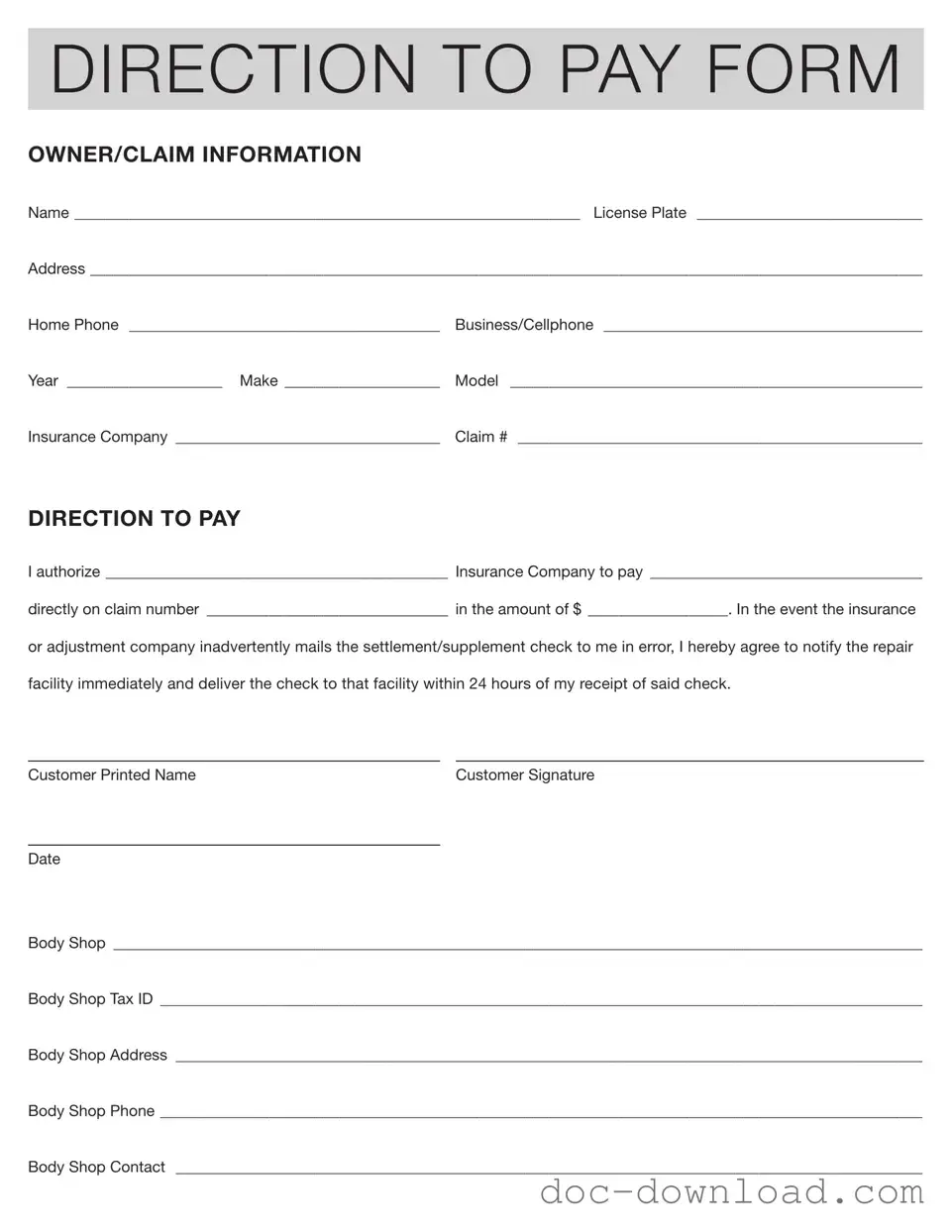The Authorization and Direction to Pay form shares similarities with the Power of Attorney document. Both documents grant authority to another party to act on behalf of an individual, but they differ in scope. A Power of Attorney can cover a wide range of decisions, including financial, medical, and legal matters. In contrast, the Authorization and Direction to Pay form is specifically focused on directing payment related to an insurance claim, making it a more limited but equally important tool in financial transactions.
Another document that is akin to the Authorization and Direction to Pay form is the Release of Liability form. When a person signs a Release of Liability, they are essentially agreeing to relinquish any future claims against another party, often in exchange for compensation. This is similar to the direction to pay, as both documents involve an agreement where one party receives payment in return for certain rights or claims. However, the Release of Liability typically pertains to personal injury or property damage claims, while the Direction to Pay is more focused on insurance settlements.
The Assignment of Benefits form is also comparable to the Authorization and Direction to Pay form. This document allows a policyholder to transfer their insurance benefits to a third party, such as a healthcare provider or repair facility. Like the Direction to Pay, the Assignment of Benefits ensures that payment goes directly to the service provider rather than the policyholder. Both forms streamline the payment process and reduce the administrative burden on the insurance company.
The Quitclaim Deed is an essential document in real estate transactions, particularly in Florida, where it allows property owners to transfer their ownership rights quickly and without extensive legal complications. It's often preferred in familial situations or simple ownership changes, ensuring that all parties involved understand the implications of the transfer. To learn more about this process and access the necessary form, visit quitclaimdeedtemplate.com/florida-quitclaim-deed-template/.
Similarly, the Claim Authorization form functions in a way that is reminiscent of the Authorization and Direction to Pay form. This document is used to give permission to an insurance company to process a claim on behalf of the insured. While the Claim Authorization form may not directly involve payment instructions, it is an essential step in the claims process, just as the Direction to Pay is crucial for ensuring that payments are directed to the appropriate party.
The Direct Deposit Authorization form is another document that aligns closely with the Authorization and Direction to Pay form. This form allows individuals to authorize their bank to deposit funds directly into their account. Like the Direction to Pay, the Direct Deposit Authorization simplifies the payment process, ensuring that funds are transferred efficiently and securely. Both documents require clear instructions to avoid any payment mishaps.
In addition, the Insurance Claim Form bears similarities to the Authorization and Direction to Pay form. While the Claim Form is primarily used to report an incident to an insurance company, it often includes sections for directing how payments should be handled. This means that both forms are integral parts of the claims process, working together to ensure that claims are filed accurately and payments are made to the right parties.
The Invoice form is also related to the Authorization and Direction to Pay form. An invoice is a request for payment for services rendered or goods provided. While the Direction to Pay specifically instructs where insurance payments should go, an invoice serves as documentation of the costs incurred. Both documents are vital for financial transactions, ensuring that payments are made promptly and accurately.
The Service Agreement can be compared to the Authorization and Direction to Pay form as well. A Service Agreement outlines the terms and conditions under which services will be provided, including payment details. While the Direction to Pay focuses specifically on directing payment for insurance claims, the Service Agreement establishes the broader framework of the relationship between the service provider and the client, including payment expectations.
Lastly, the Settlement Agreement is akin to the Authorization and Direction to Pay form. A Settlement Agreement is a legally binding document that outlines the terms of a settlement between parties, including payment amounts and timelines. Both documents facilitate the resolution of disputes and the efficient transfer of funds, ensuring that all parties are clear on their rights and obligations.

